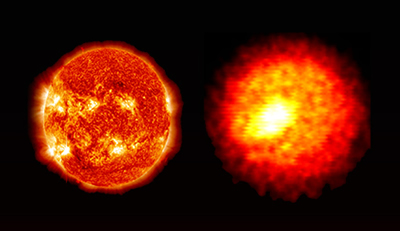Nuclear Astrophysics

The Origins of ‘Starstuff’
One of the great scientific challenges is understanding how elements form. This process, called nucleosynthesis, occurs at extreme stellar temperatures and pressures, making it difficult to simulate in the laboratory. The conditions produced by NIF experiments, however, are well matched to the conditions that exist in stars in several phases of their evolution. As a result, NIF is a powerful tool for exploring nuclear astrophysics.
Elements heavier than iron are formed either slowly, during the life of a star, or rapidly, during a star’s last few seconds. NIF can more realistically replicate the hot, dense stellar plasma where both processes occur in nature than is possible in other laboratory experiments.
Livermore physicists have been studying studying the slow nucleosynthesis process, or s-process. This reaction has a relatively large cross-section—a quantity that describes the probability that reactants will undergo a fusion reaction— at stellar temperatures and densities, so it has been studied to high accuracy in laboratory experiments using low-energy accelerators.
Measuring Nuclear Cross Sections
 Despite staggering differences in mass and scale—the sun (left) is approximately 1038 times more massive and 1013 times larger—NIF implosions (right) are being used to recreate the conditions found in the deep interiors of stars.
Despite staggering differences in mass and scale—the sun (left) is approximately 1038 times more massive and 1013 times larger—NIF implosions (right) are being used to recreate the conditions found in the deep interiors of stars. Accelerator experiments have measured the cross-sections for most stable nuclei. Measuring cross-sections of unstable short-lived nuclei has been impossible, however, in part because such studies would require unsafe quantities of radioactive material. Another complication is that nuclei in a stellar plasma often exist in excited states that modify capture probability.
NIF holds advantages over accelerators. Laser experiments require a much smaller quantity of radioactive material than accelerators, allowing the experiments to be safely performed. Radioactive (or short-lived) elements can also be directly created at NIF, but not in accelerators.
In experiments using the indirect-drive approach to inertial confinement fusion (ICF), the NIF lasers drove a gas-filled capsule implosion, heating target capsules to extraordinary temperatures and compressing them to high densities where fusion reactions can occur. These experiments were the first thermonuclear measurements of nuclear reaction cross-sections in high-energy-density plasma conditions that are equivalent to the burning cores of giant stars, 10 to 40 times more massive than the sun.
With NIF, scientists can produce stellar conditions with much higher quantities of neutrons. In addition, the laser energy compresses the target, reducing its area by a factor of 1,000, boosting the density of nuclei, and increasing the probability of a neutron hitting a nucleus.
Because of the additional neutrons and the extremely dense target material, an astonishing 2,800 years of stellar neutron capture occurs in every NIF shot. Even for short-lived nuclei, multiple reactions are possible in a single shot, potentially advancing scientific understanding of nucleosynthesis far more rapidly than accelerator-based experiments.
More Information
“Scientists Predict Reaction Data for Fusion Research, Insight into Universe’s Origins,” NIF & Photon Science News, February 6, 2019
“Probing the Conditions of Stellar Interiors,” NIF & Photon Science News, August, 2017
“NIF Experiments Study How ‘Starstuff’ Is Made” NIF & Photon Science News, June, 2016
Next up: Planetary Physics



